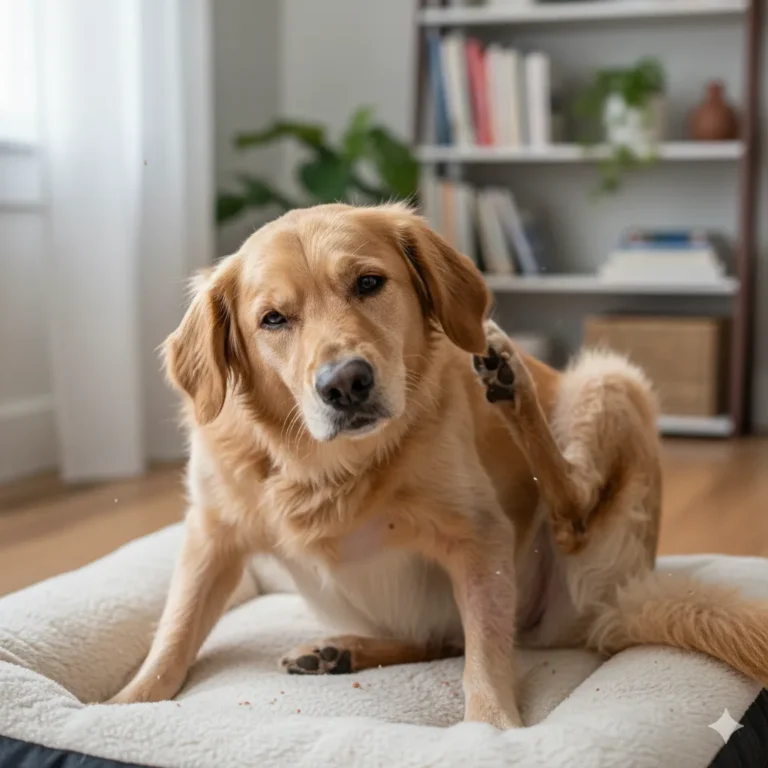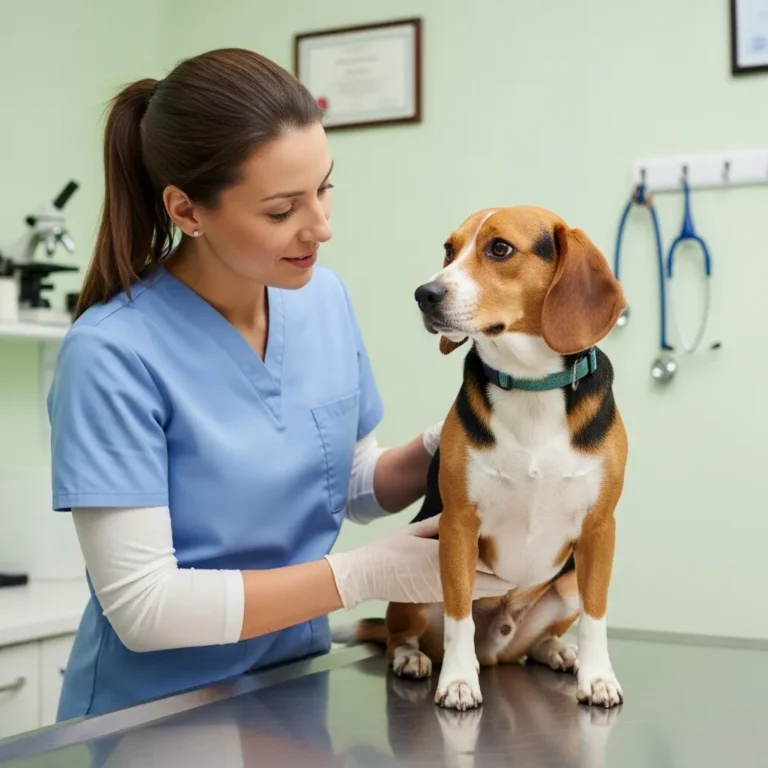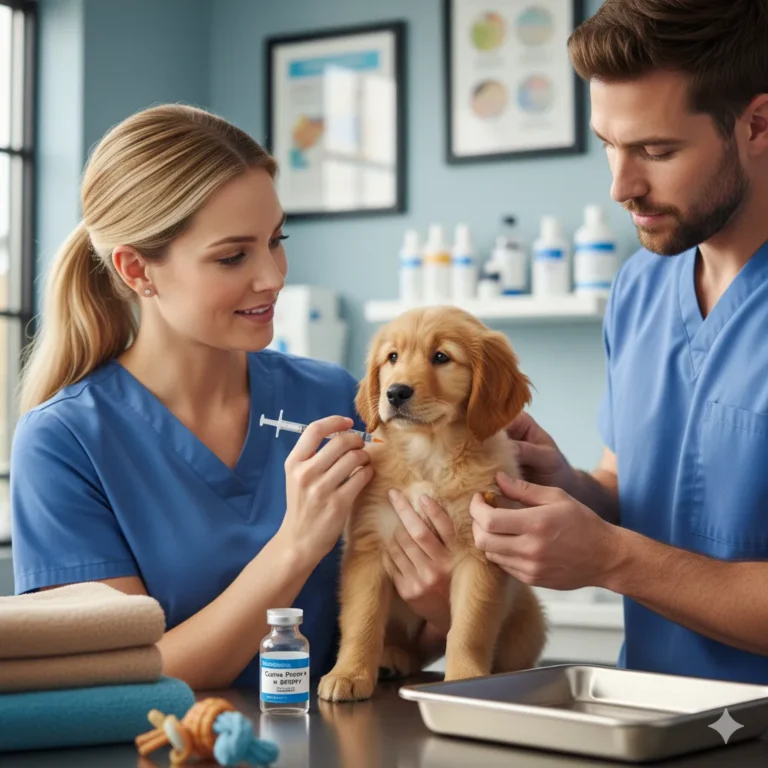
Author: DogsBlogSS Team
⚠️ Disclaimer: This article is for informational purposes only and is not a substitute for consulting a veterinarian.
torn anterior cruciate ligament in dogs
When your dog suddenly begins to favor one of its back legs, seems stiff on walks, or even holds its foot off the ground, it’s easy to worry. One of the common but often misunderstood culprits is a torn anterior cruciate ligament in dogs (ACL) — in dogs, more accurately known as a cranial cruciate ligament (CCL) rupture. This injury can be painful, immobilizing, and over time, cause arthritis if left unchecked.
But the good news is that, whether through surgery or careful conservative management, many dogs go on to live happy, active lives after a CCL tear. In this article, I’ll walk you through everything you need to know—what it is, why it happens, how it’s diagnosed, and what your options are for helping your four-legged friend bounce back.
Understanding Canine ACL Tears (Cranial Cruciate Ligament Rupture)
What is a Canine ACL Tear?
When people talk about an “ACL tear,” they usually refer to humans. In dogs, the same ligament is called the cranial cruciate ligament (CCL), and when it’s injured or ruptured, the result is a CCL disease — commonly called a canine ACL tear.
What is the cranial cruciate ligament (CCL) in dogs?
According to acvs: The cranial cruciate ligament connects the femur (thigh bone) to the tibia (shin bone) inside the knee (or “stifle”) joint. It’s essential for stabilizing the joint, especially preventing the tibia from sliding forward when the dog puts weight on its leg. Without that stability, the knee becomes painfully unstable.
According to acvs: The CCL also helps control rotational forces within the joint, and it works alongside menisci (cartilage “cushions”) to absorb shock.
What does a torn ACL (CCL) mean for my dog?
According to acvs: When the CCL tears — whether partially or completely — your dog’s knee loses its natural stability. That leads to abnormal movement in the joint, pain, inflammation, and over time, can contribute to arthritis. Many dogs will gradually change how they walk, begin to shift weight off the leg, or limp.
According to ecvc: Left untreated, the constant instability often leads to progressive joint degeneration and meniscal injury.
Is a torn ACL in dogs the same as in humans?
According to acvs: The basic idea is similar: it’s a ligament injury inside the knee joint. But there are important differences. In humans, ACL tears often happen from a sudden accident (like pivoting during sports). In dogs, CCL rupture is more often due to long-term degeneration of the ligament, not a single traumatic event.
According to acvs: Also, while in humans surgeons often reconstruct the ligament, in dogs they don’t usually replace it — instead, they change the biomechanics of the joint (through surgery) or rely on scar tissue to stabilize things.
Causes and Risk Factors
What causes an ACL tear in dogs?
There’s no single cause. Rather, CCL ruptures are typically multifactorial, meaning many things combine over time to weaken the ligament:
- According to acvs: Degeneration (aging): The ligament fibers gradually fray and weaken.
- According to drloudon: Genetics: Some breeds are more predisposed.
- According to premiervet: Obesity: Extra weight puts more stress on the joint.
- According to drloudon: Joint conformation: Poor bone angles, steep tibial plateau (slope), or other skeletal factors increase risk.
- According to drloudon: Activity/contact: Repetitive high-impact exercise, or even minor trauma, may accelerate wear.
- According to drloudon: Hormonal factors: Some research (and veterinarians) note that early spaying or neutering may influence ligament health.
Are certain dog breeds more prone to ACL tears?
According to acvs: Yes — genetics matters. According to the American College of Veterinary Surgeons (ACVS), breeds like Labrador Retrievers, Rottweilers, Newfoundlands, Staffies, Mastiffs, Akitas, Saint Bernards, and Chesapeake Bay Retrievers are more frequently affected.
According to acvs: On the other end, some breeds like Greyhounds, Dachshunds, Basset Hounds, and Old English Sheepdogs have a lower incidence.
Does age or weight play a role in ACL tears?
According to acvs and Dr. Loudon: Absolutely. Age-related degeneration is a key factor — as dogs get older, their ligaments weaken. Excess weight only makes it worse, because the joint has to absorb more force, stressing the ligament and surrounding structures.
Can minor trauma lead to an ACL tear, or is it always a sudden injury?
According to drloudon: Minor trauma can play a role, but it’s rarely the sole cause. More often, a dog’s ligament has already been weakening for some time, and a small stumble or awkward jump may be the final straw. Occasionally, though, more sudden tears happen — especially in very active dogs or those jumping or twisting.
Is an ACL tear usually a chronic or acute problem in dogs?
According to acvs: In most cases, a CCL tear in dogs is chronic, not acute. The ligament tends to degenerate over months or years, and many dogs experience a progressive decline. That said, some dogs do present acutely, especially if they experience a sudden worsening or complete rupture after a partial tear.
Recognizing the Symptoms
What are the common signs of an ACL tear in dogs?
Some common warning signs include:
- Limping or lameness in one back leg
- Swelling around the knee (stifle) joint
- Stiffness — especially after resting
- Difficulty rising, jumping, or climbing stairs
- Decreased activity or reluctance to play
- According to reddit: Muscle loss in the affected thigh (because the dog is not using that leg as much)
Will my dog always limp if they have an ACL tear?
According to reddit:Not always. Surprisingly, some dogs develop a limp that comes and goes. Others may start putting more weight on the leg again, as their body tries to compensate.There are even stories (from dog owners) of dogs walking fairly normally soon after a diagnosis — but that doesn’t mean the injury has healed.
Can a dog still put weight on their leg with a torn ACL?
According to reddit: Yes. Depending on the severity and whether the tear is partial or complete, your dog may still bear weight. Over time, scar tissue (fibrosis) can develop, which helps stabilize the joint for some dogs. But that’s not the same as the ligament healing itself — and instability often remains.
How can I tell if my dog has an ACL tear versus another type of leg injury?
It’s tricky as an owner, because limping or favoring a leg could be from several things: joint arthritis, a fracture, muscle strain, or even hip issues. The best way to know is through a veterinary exam, possibly including imaging (X-rays) and specific orthopedic tests. The vet may perform a “cranial drawer test” (more on that below) or other orthopedic manipulations to check for instability.
Diagnosis and Confirmation
How is a torn ACL diagnosed in dogs?
A proper diagnosis usually begins with a physical exam by a veterinarian. The vet will observe your dog walking, palpate (feel) the knee joint, check for swelling, and assess pain. Then they may run more specific orthopedic tests and imaging to confirm.
What tests will the vet perform to confirm an ACL tear?
- Orthopedic exam: Includes feeling for instability in the joint.
- Cranial drawer test: The vet gently stabilizes the hip and tries to move the tibia forward relative to the femur; abnormal “drawer” motion suggests a torn CCL.
- Radiographs (X-rays): To rule out other bone problems and assess joint alignment or arthritis.
- According to todaysveterinarypractice: Arthroscopy or advanced imaging (in some cases): To look inside the joint and examine structures like the meniscus.
Is an X-ray enough to diagnose an ACL tear?
X-rays help, but they can’t show ligaments directly. They’re very useful to rule out fractures, check for arthritis, or evaluate bone conformation (like the angle of the tibial plateau). But to confirm a torn ligament, veterinarians rely on a combination of physical tests (like the drawer test) and sometimes more advanced imaging.
What is the “cranial drawer test” and how accurate is it?
The cranial drawer test is a hands-on orthopedic maneuver: the vet stabilizes the femur and gently tries to move the tibia forward (“pulling the drawer”). If it shifts more than it should, that suggests a ruptured or damaged CCL. It’s a widely used clinical test, but it’s not 100% foolproof — false negatives can occur, especially in dogs with partial tears or guarded muscles. Many vets use it in combination with other diagnostic tools.
Treatment Options: Surgical vs. Non-Surgical
What are the treatment options for a torn ACL in dogs?
Broadly, you have two paths:
- Surgical repair — to restore or compensate for stability
- Non-surgical (conservative) management — relying on rest, bracing, physical therapy, and scar tissue stabilization
Is surgery always necessary for an ACL tear?
According to acvs: Not always, but very often. According to the American College of Veterinary Surgeons (ACVS), surgery is typically recommended because it’s the only way to permanently address the instability in many dogs. However, whether surgery is best depends on several factors: your dog’s size, age, activity level, health, and whether there’s arthritis already.
What are the different types of ACL repair surgeries (TPLO, TTA, Lateral Suture, etc.)?
Here are some of the most common surgeries:
- According to vmsg: TPLO (Tibial Plateau Leveling Osteotomy): Cuts and repositions the top of the tibia to change the mechanics of the joint.
- According to vmsg: TTA (Tibial Tuberosity Advancement): Moves part of the tibia forward (the tibial tuberosity) and secures it, stabilizing the knee in a different way.
- According to caninejournal: Extracapsular lateral suture (Lateral Suture): Uses strong sutures (or synthetic material) placed outside the joint to mimic the ligament. Good for small or medium dogs.
- According to wikipedia: Triple Tibial Osteotomy (TTO): A more specialized surgery involving three bone cuts.
- According to pmc.ncbi.nlm.nih: Novel techniques (experimental): For example, a study combined graft from the dog’s own tendon plus platelet-rich plasma (PRP) to promote healing.
Which surgical procedure is best for my dog?
According to pmc.ncbi.nlm.nih: There’s no one-size-fits-all. According to a systematic review by Annika Christina Wemmers, Marios Charalambous, Oliver Harms, and Holger Andreas Volk, both TPLO and TTA are effective, but each has pros and cons — and the evidence doesn’t strongly favor one over the other. For example:
- According to frontiersin: TPLO may have a lower risk of surgical site infections.
- According to pmc.ncbi.nlm.nih.gov: TTA may lead to better early osteoarthritis scores (in some studies).
- According to caninejournal:Extracapsular suture is less invasive and cheaper, but might not be ideal for very large or very active dogs.
According to todaysveterinarypractice: James K. Roush, DVM, MS, a board-certified surgeon and professor at Kansas State University College of Veterinary Medicine, has noted that TPLO provides excellent return of function (85–95 %) and high owner satisfaction.
Ultimately, the “best” option depends on:
- Your dog’s size and health
- How active they are or will be post-op
- Your vet’s or surgeon’s experience
- Financial considerations and access to a skilled orthopedic surgeon
What is the success rate of ACL surgery in dogs?
Very good, in many cases. Veterinary literature often reports owner satisfaction rates above 90% for both TPLO and TTA.
According to pmc.ncbi.nlm.nih: According to Wemmers et al., long-term studies show that many dogs regain nearly normal gait and function—even though some degree of arthritis often develops.
According to mvma: Major complication rates vary, but are often acceptable.
Can an ACL tear heal on its own without surgery?
According to acvs: Not really in the sense of true ligament regeneration. Dogs may form scar tissue (fibrosis) that helps stabilize the joint, but this doesn’t replicate a healthy, functional CCL. the joint often remains unstable and is at high risk for ongoing degeneration, pain, and arthritis.
What are the non-surgical treatment options for ACL tears?
- Strict rest and activity restriction (no jumping, running)
- Weight management (if overweight)
- Physical therapy (PT) / rehabilitation
- According to vmsg: Knee brace (brace support plus rest can help the ligament stabilize)
- Anti-inflammatory medications or pain relief, under vet supervision
When is non-surgical management appropriate?
Conservative (non-surgical) management may be chosen when:
- The dog is small or less active
- The tear is partial or mild
- Surgery is not feasible (cost, health risk)
- The owner wants to try non-invasive options first
According to todaysveterinarypractice: That said, some vets caution that non-surgical management is not a guarantee, and long-term joint stability may remain compromised.
Surgical Procedures: Details and Recovery
What does ACL surgery involve?
Depending on the procedure:
- According to vmsg: For TPLO, the surgeon cuts and levels the tibial plateau (the top of the shin bone), then secures it with a metal plate and screws to alter mechanics of the joint.
- According to vmsg: For TTA, they cut and move the tibial tuberosity forward and fix it, changing the force vector of the patellar tendon.
- According to caninejournal: For extracapsular suture, the surgeon places a strong suture or synthetic material outside the joint to mimic the torn ligament.
- According to wikipedia: For triple tibial osteotomy (TTO), three cuts are made in the tibia to reposition bone segments.
- According to pmc.ncbi.nlm.nih: In experimental techniques, they may graft tendon plus use platelet-rich plasma (PRP) to augment healing.
How long does ACL surgery take?
Surgery time varies depending on the technique and the surgeon’s experience, but typically, a TPLO or TTA might take 1 to 2 hours, plus prep and closing time.
What are the risks associated with ACL surgery?
Like any surgery, there are risks:
- IAccording to pubmed: nfection at the surgical site (surgical site infection)
- According to pubmed: Implant failure (plates, screws)
- According to ecvc.memberclicks: Meniscal injury (especially medial meniscus)
- According to ecvc.memberclicks: Reoperation may be required in some cases
- According to pmc.ncbi.nlm.nih: Progression of arthritis over time — surgery doesn’t always stop osteoarthritis
What is the typical recovery time after ACL surgery?
Recovery is gradual and cautious:
- First few days: pain management, restricted activity
- 2–4 weeks: limited leash walking, rest, maybe physical therapy
- 8–12 weeks: gradual increase in movement, under guidance
- According to mvma: 6–12 months: full recovery can take this long, depending on procedure, follow-up PT, and how the dog responds
What should I expect immediately after my dog’s ACL surgery?
Expect some swelling, discomfort, and decreased mobility at first. Your vet or surgeon will provide pain medications, antibiotics (if needed), and instructions for care. You may need to restrict your dog’s movement, use a cone (if they try to lick stitches), and help them with basic needs.
How do I care for my dog during the post-operative period?
- Strict rest (crate or confinement area)
- Controlled leash walks only
- Monitor surgical site daily for signs of infection
- Follow-up visits to the vet/surgeon
- Start prescribed physical therapy (rehab) when cleared
- Nutritional management — good quality food, possibly joint-support supplements
When can my dog start walking again after surgery?
Walking begins early (within days) but in a controlled, limited way. Over weeks you’ll slowly allow more walking, under supervision. Full, unrestricted activity is only reasonable months later, once healing is confirmed.
What is physical therapy like after ACL surgery?
Physical therapy may include:
- Passive range-of-motion exercises
- Gentle weight-shifting and balance exercises
- Hydrotherapy or underwater treadmill (if available)
- Strengthening exercises for the hind limb and core
- Gradual progression to more challenging exercises, as the dog heals
Rehab helps rebuild muscle, reduce stiffness, and promote optimal joint function.
Are there any long-term complications after surgery?
Possible long-term issues include:
- According to frontiersin: Arthritis / osteoarthritis (joint degeneration) even with surgery
- Meniscal damage later on
- Implant irritation or failure (rare)
- Potential risk of tearing the other (contralateral) ligament
Non-Surgical Management: Details and Expectations
What does conservative management for an ACL tear involve?
As mentioned earlier, non-surgical management usually means:
- Strict rest + limited activity
- According to vmsg: Use of a knee brace for support
- Weight control (diet, managing obesity)
- Physical therapy / rehab
- Anti-inflammatory or pain-relief medications
How effective is non-surgical treatment for ACL tears?
According to todaysveterinarypractice: It can work — especially in small or less active dogs — but it’s not always ideal. Without surgery, the joint may remain unstable, leading to ongoing degeneration. Success often depends on discipline (rest, therapy) and regular veterinary follow-up.
What kind of activity restrictions are needed with non-surgical treatment?
Strict: no jumping, no rough play, on-leash only, short controlled walks. Over time, as the dog stabilizes, some limited activity may be allowed, but the risk of further injury remains.
Can braces or supports help a torn ACL without surgery?
According to vmsg: Yes, knee braces can be helpful. According to Ventura Veterinarians, a brace may stabilize the knee enough to allow scar tissue formation and reduce discomfort, especially when used with restricted activity. However, braces are not a cure — they support, but don’t reconstruct the ligament.
What are the potential downsides of not having surgery?
- Continued instability → pain, lameness
- According to acvs: High risk of developing arthritis
- According to ecvc: Possible meniscal injury over time
- The other knee may also degenerate (because of compensating)
- Quality of life may gradually decline
Prognosis and Long-Term Outlook
What is the long-term prognosis for dogs with ACL tears?
According to mvma: If treated appropriately (with surgery or well-managed conservative care), many dogs do very well long-term. Owners often report high satisfaction, and functional recovery is common.
According to pmc.ncbi.nlm.nih: Even with surgery, though, many dogs will develop some level of osteoarthritis over time.
Will my dog ever fully recover from an ACL tear?
“Fully” depends on what you mean. Many dogs recover to a point where they move well, don’t limp, and enjoy near-normal activity. But perfect, pre-injury joint structure may not always be achieved, especially if arthritis sets in. Still, quality of life can be very good.
Is my dog at risk of tearing the other ACL after one tear?
According to reddit: Yes, that’s a real concern. Several veterinarians warn that once one CCL is ruptured, the opposite side can be at risk, especially if the underlying factors (weight, conformation, genetics) remain. Owners often need to monitor, manage weight, and consider preventive care.
Will my dog develop arthritis after an ACL tear, even with surgery?
According to pmc.ncbi.nlm.nih: Unfortunately, yes — that’s a very likely scenario. Multiple studies (including the meta-analysis by Wemmers et al.) show that osteoarthritis typically develops over time, even after surgical repair. But surgery often slows the progression, reduces pain, and improves joint function.
How can I prevent future ACL tears in my dog?
Some proactive steps:
- According to drloudon: Maintain a healthy weight — critical.
- According to drloudon: Provide moderate, controlled exercise — avoid repeated high-impact actions.
- According to drloudon: Strengthen muscles: low-impact activities like swimming help
- According to drloudon: If your dog is young, talk to your vet about timing of spay/neuter; some data suggests early neutering can affect joint development.
- Follow up with your veterinarian and monitor both knees over time
Cost and Financial Considerations
How much does ACL surgery typically cost?
It varies widely depending on location, surgeon expertise, and the type of surgery. In many places, TPLO or TTA can cost several thousand dollars. Some owners report costs in the range of $4,000–$10,000+ depending on complexity and aftercare. (Estimates are based on real owner experiences and veterinary centers.)
Are there less expensive treatment options available?
Yes — extracapsular suture is often less expensive than TPLO or TTA. Conservative management (rest, bracing, PT) is also more affordable but may come with trade-offs in stability and long-term joint health.
Does pet insurance cover ACL surgery?
According to investopedia: Sometimes. According to a breakdown on pet insurance, many comprehensive plans may cover CCL/ACL surgery, but it depends on the policy, how “pre-existing conditions” are defined, and whether there are restrictions.
It’s important to read the fine print of any pet insurance plan, ask about surgical coverage, and whether bilateral injuries (both knees) are covered differently.
Living with an ACL Injury
What can I do to help my dog be more comfortable?
- Keep activity gentle and controlled
- Use soft bedding to support the joint
- Consider joint supplements (with your vet’s approval)
- Maintain ideal weight to reduce joint stress
- Use pain medication or anti-inflammatories as prescribed
- Provide physical therapy or rehab support
Are there supplements or medications that can help?
Yes, certain supplements may support joint health (but always check with your vet):
- Glucosamine / chondroitin
- Omega-3 fatty acids (fish oil)
- Joint-specific formulations (as advised by your vet)
Medication-wise, vets often prescribe NSAIDs (non-steroidal anti-inflammatories) to control pain and inflammation, especially in the early phase.
What kind of exercise is safe for a dog with an ACL tear?
- Short, controlled leash walks
- Swimming (if allowed by the vet) — very low-impact and great for muscle
- Gentle physical therapy exercises
- Avoid jumping, rough play, or fast running until cleared by a vet
How can I modify my home to help my dog during recovery?
- Use non-slip rugs or runners so your dog can walk safely
- Provide a ramp or steps for getting onto beds or into cars
- Keep food and water easily accessible so they don’t need to jump around
- Limit stairs if possible (or supervise use carefully)
- Create a cozy rest area where they feel safe and supported
Conclusion
A torn ACL (CCL rupture) in dogs can be scary, but it’s also a very manageable problem many pet owners and veterinarians deal with successfully. Whether you choose surgery (like TPLO or TTA) or a conservative route (brace, rest, rehab), the goal is the same: restore as much comfort, stability, and function to your dog as possible. With the right care, many dogs go on to lead happy, active lives — maybe not like nothing ever happened, but certainly with a good quality of life.
If you suspect your dog may have a CCL injury, don’t wait — talk to your vet, get an orthopedic evaluation, and together find a treatment path that works for you and your dog. And remember: post-care (rest, rehab, weight management) is just as important as the decision to operate.
Notice : The DogsBlogSS editorial team is dedicated to providing accurate, research-based information about dog health, behavior, and care. All our articles are fact-checked using trusted veterinary sources such as VCA Hospitals, Merck Vet Manual, and the AKC.
you may like it






Sources
- https://www.petmd.com/dog/procedure/acl-surgery-in-dogs
- https://pubmed.ncbi.nlm.nih.gov/36532339/
- https://www.investopedia.com/does-pet-insurance-cover-acl-surgery-8675532
- https://www.petplace.com/article/dogs/pet-insurance/torn-acl-in-dogs-pet-insurance-coverage-and-costs
- https://articles.hepper.com/does-pet-insurance-cover-cruciate-surgery/
- https://www.cgaa.org/article/does-pet-insurance-cover-acl-surgery
- https://kttpharm.com/does-pet-insurance-cover-acl-surgery/
- https://articles.pangovet.com/insurance/does-metlife-pet-insurance-cover-cruciate-surgery/


